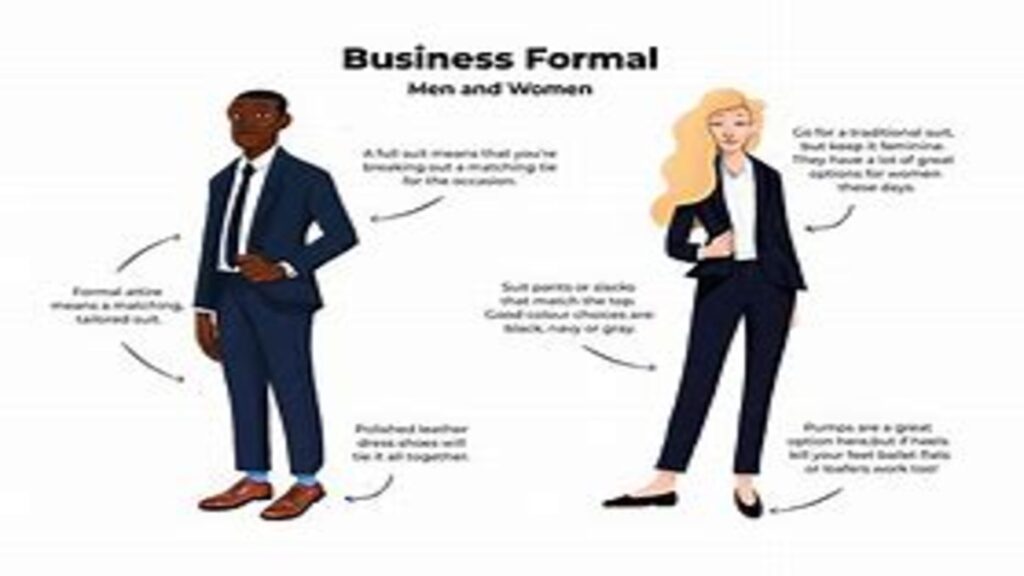When you hear the term “business formal”, it might conjure images of stiff suits, monotone colors, or corporate boardrooms. But business formal isn’t about being boring it’s about dressing with professionalism, polish, and purpose. Whether you’re preparing for a big job interview, an important business meeting, or working in a corporate environment with high dress standards, understanding the ins and outs of business formal can make all the difference.
Let’s break down what business formal means, how it differs from other dress codes, and how you can rock it with style and confidence.
What is Business Formal Attire?
Business formal is the highest level of professional dress code in a workplace. It’s often required in industries like law, finance, government, and corporate leadership. The goal is to present yourself as polished, capable, and ready for serious business.
Why Business Formal Still Matters
Even in today’s more relaxed work culture, business formal continues to be relevant in:
- High-stakes meetings
- Client presentations
- Corporate interviews
- Boardrooms and legal settings
- Events or functions with senior executives
Your appearance communicates your attention to detail and professionalism two qualities that business formal dress conveys effectively.
Business Formal vs. Business Casual: What’s the Difference?
Let’s clear up a common confusion.
| Business Formal | Business Casual |
|---|---|
| Suits and ties | Dress shirts without ties |
| Neutral colors | Flexibility in color/patterns |
| Conservative shoes | Loafers, dress sneakers |
| Professional accessories | More relaxed style allowed |
Think of business formal as what you wear to a courtroom or an executive meeting, while business casual is what you wear to a networking lunch.
Business Formal for Men
1. Suit Up Right
- A dark, tailored suit in navy, black, or charcoal
- Single or double-breasted jacket
- Matching trousers
2. Crisp Dress Shirt
- White or light blue cotton shirt
- Long sleeves with collar
- No loud prints or patterns
3. Tie and Pocket Square
- A silk tie in a conservative color or pattern
- Optional pocket square for a polished finish
4. Shoes Matter
- Black or dark brown Oxford or Derby shoes
- Clean and well-polished
- Coordinated belt and socks
Business Formal for Women
1. Structured Suits or Dresses
- Pantsuits, skirt suits, or formal sheath dresses
- Neutral tones like black, navy, or grey
- Knee-length skirts are ideal
2. Dress Shirts and Blouses
- Simple blouses or button-down shirts
- Avoid low-cut or overly embellished tops
3. Tights and Hosiery
- Neutral-toned hosiery for skirt or dress outfits
- Black opaque tights are fine in cooler months
4. Closed-Toe Footwear
- Pumps or loafers in black or nude
- Heels should be modest (2-3 inches max)
Seasonal Considerations
Summer Business Formal Tips
- Choose lightweight fabrics like linen blends or tropical wool
- Opt for lighter colors like light grey or beige suits
- Breathable dress shirts to stay comfortable
Winter Business Formal Tips
- Layer with structured wool coats
- Wear scarves and gloves in conservative styles
- Add thicker socks or tights for warmth
Business Formal Accessories: Less is More
For Men:
- Classic watch
- Leather belt and briefcase
- Avoid chunky jewelry
For Women:
- Stud earrings or simple pearls
- Structured tote or handbag
- Light makeup and tidy hair
Accessories should never overshadow your outfit—they’re meant to enhance it subtly.
Grooming and Presentatio
No matter how sharp your suit is, presentation is everything.
- Hair should be neat and clean
- Nails trimmed and tidy
- Avoid overpowering cologne or perfume
- Ironed clothes with no wrinkles
A well-groomed look completes the business formal aesthetic and shows you take yourself—and your role—seriously.
Conclusion
Business formal isn’t just about looking good—it’s about commanding respect and radiating confidence. Whether you’re sealing deals in a boardroom or walking into an interview, how you dress sets the tone for how people see you. And when you’re dressed sharply, you feel more prepared, more focused, and more empowered.
So suit up, show up, and own your professional presence.
FAQs
1. Can I wear a business formal outfit to a wedding?
Yes, if the wedding is formal or black-tie optional, a business formal suit or dress works well. Stick to elegant colors and accessories.
2. Are jeans ever acceptable in business formal?
No, jeans even dark or tailored ones are considered too casual for a business formal setting.
3. How many suits should I own for a business formal wardrobe?
Start with two to three high-quality, versatile suits in neutral colors, and build from there.
4. Can women wear open-toed shoes in business formal attire?
Generally, closed-toe shoes are preferred, especially in conservative industries. Peep-toes may be acceptable in some environments but always check the company culture.
5. Is a turtleneck appropriate in business formal?
Turtlenecks are more business casual unless paired smartly with a blazer in creative industries. Stick to dress shirts for traditional business formal events.







